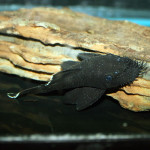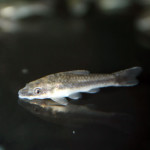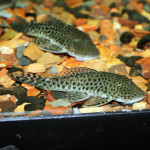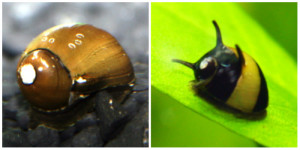Finding the perfect new addition to an aquarium is often like finding the Holy Grail to many aquarists. We all want the perfect little helper to keep the tank clean so there’s less work for us to do (and so our tank is cleaner and healthier, of course) but many “algae eaters” get too large for smaller aquariums and many others like the group of fish known as “plecos” don’t even eat algae at all. So what are the best plecos and algae eaters for small freshwater aquariums? Here are a few of our favorites that are some of the best choices for smaller community aquariums:
Bushynose & Bristlenose Plecos (genus Ancistrus)
- PROS: Lots of variety in color and pattern, small size, vegetation-heavy diet (including algae), community-friendly.
- CONS: Some species grow larger than others, needs meaty foods as well, underfed fish may eat live plants.
- BEST SUITED AS: A community algae-eater and bottom-feeder.
Plecos from the genus Ancistrus usually have “Bristlenose” or “Bushynose” somewhere in their common names, a nickname that comes from the whisker-like frills that develop on most adults. They are usually more prominent in adult males but some females may get them too in some species. Different species in this group have different requirements, but they are generally among the smallest plecos. While they eat some meatier foods as well, most appear to eat mostly vegetation.
Clown Pleco (Panaque maccus L104)
- PROS: Small size, easy-going temperament, fairly wide-spread diet.
- CONS: Need driftwood for grazing, not primarily an algae-eater.
- BEST SUITED AS: A general clean-up bottom-feeder for community aquariums.
The Clown Pleco is a popular small pleco. As with other Panaque plecos, these fish are omnivores and feed about equally on plants matter and meatier foods. Panaque plecos are also unique in that they actually feed on driftwood as well; make sure you have driftwood décor in your tank for these fish to graze on.
Hillstream Loaches
- PROS: Eats algae, can be kept in groups, unique and unusual appearance.
- CONS: Needs high flow and pristine water, vulnerable to aggressive tankmates and poor water chemistry.
- BEST SUITED AS: A unique addition to a suitable community aquarium where it incidentally may help eat algae but isn’t the primary algae-eater.
Hillstream Loaches have flattened guitar-shaped bodies and are often mistaken for plecos. They cling to rocks in the fast-moving mountain stream where they come from much like plecos cling to surfaces. Hillstream Loaches need well-oxygenated and well-filtered tanks and don’t do well with nippy tankmates or in tank with less-than-pristine water quality. They do eat some algae however, as well as other detritus and leftover sinking foods.
Otocinclus Catfish
- PROS: Small size, safe for planted tanks, primarily algae-eaters.
- CONS: Can be sensitive to stress, can starve if they can’t find enough to eat.
- BEST SUITED AS: Algae-eating housekeepers in planted community aquariums.
There are a few very similar species that are commonly grouped together as Otocinclus Catfish (“Oto Cats”) or “Dwarf Suckermouth Catfish”. Most are brownish-grey in color with a black stripe but some like the Zebra Oto (Otocinclus cocama) have a more ornate pattern. These fish stay under two inches in length and are great for eating algae off of plants without harming the plants. They can be a bit finicky and sensitive though so only keep in a stable, healthy aquarium. They are also best kept in groups so plan tankspace accordingly.
Rubbernose Plecos (Chaetostoma sp.)
- PROS: Moderately small adult size, eats some algae, community temperament.
- CONS: Not a primary algae-eater, can be bulky for very small tanks.
- BEST SUITED AS: A general bottom-feeder for community tanks over about 30-45 gallons.
Like the Clown Pleco, Rubbernose Plecos are some of the most common smaller plecos available. They also have a very familiar pleco-like appearance that many novice aquarists associate with algae control. They are not exclusive algae-eaters however; this is another omnivore that needs about equal parts meaty food and plant matter. These fish are pretty middle-of-the-road overall: moderate adult sizes, eats diet for about half their diet, neutral coloration, moderate temperament.
Freshwater Nerite Snails
- PROS: Colorful shells, safe for plants, small size.
- CONS: Limited availability, may reproduce, may be vulnerable to predators.
- BEST SUITED AS: Algae-eating grazers for small planted aquariums.
Nerite Snails are popular for saltwater aquariums but some species are found in freshwater as well. These snails are much smaller than some of the other less-suitable and more invasive freshwater snails like Apple Snails or Trapdoor Snails. They mainly eat smaller algaes like the ones that cause spots on glass but usually won’t harm plants. These snails also appear to bred less frequently in most aquariums than the more common Apple Snails. Make sure the ones you get are from freshwater; a saltwater Nerite will not survive being moved to a freshwater tank.
Freshwater Shrimp (Caridina sp.)
- PROS: Safe for plants, small size, can be kept in groups.
- CONS: Limited availability, vulnerable to predators, very small.
- BEST SUITED AS: Algae-eaters for planted nano tanks with peaceful or no other tankmates.
Small freshwater shrimp like the popular Cherry Shrimp and Amano Shrimp can be ideal grazers, especially for nano tanks (under 1-2 gallons). Some are clear, some are colored or have colored markings and they can be kept in groups. However, most of these shrimp are very small; you may not see them often and can’t be kept with anything remotely predatory.
As always, the best algae-eater for your tank depends on its tankmates, the size of the tank, the water parameters and other such factors but hopefully this helps give you some alternatives to fish that may be too big or otherwise unsuitable to your needs. If you need more help in making your best choice or have a favorite of your own, feel free to comment below!
 That Fish Blog – Aquarium Advice and Information
That Fish Blog – Aquarium Advice and Information








 Let me start with Brochis multiradiatus, otherwise known as the
Let me start with Brochis multiradiatus, otherwise known as the  Want something weird? Well, the first time I saw the
Want something weird? Well, the first time I saw the  dark coloration with tiny white speckles covering the front half of its body. The edges of its tail and dorsal fin are a bluish-white color. These are highly prized by breeders and collectors. These plecos only attain a size of about 4 inches. I can see how some people are absolute fanatics about this fish.
dark coloration with tiny white speckles covering the front half of its body. The edges of its tail and dorsal fin are a bluish-white color. These are highly prized by breeders and collectors. These plecos only attain a size of about 4 inches. I can see how some people are absolute fanatics about this fish.